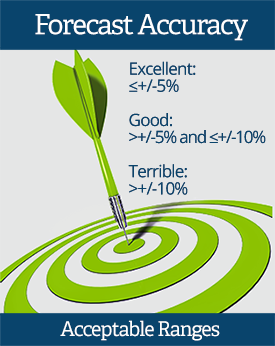The Definitive Way to Measure and Grade Sales Forecast Accuracy
- According to SiriusDecisions research, 79 percent of sales organizations miss their sales forecast by more than 10 percent
- To improve forecast accuracy, organizations must first define what it is, and then find an acceptable range of accuracy
- Consider attending our annual SiriusDecisions Sales Leadership Exchange for more on sales forecasting
Until now, a standard formula to measure and grade sales forecast accuracy has eluded sales and sales operations. What we do know is that most sales organizations are terrible at forecasting, no matter how forecast accuracy is measured. According to SiriusDecisions research, 79 percent of sales organizations miss their forecast by more than 10 percent. [Tweet this stat]

To end the debate and get on with the mission of improving accuracy, here’s the definitive way to measure and grade forecast accuracy going forward.
Forecast Accuracy Defined
Sales forecast accuracy is the absolute percentage difference between the Day One forecast and cumulative sales results achieved through the last day of the forecast period. That’s it!
The Day One forecast is the first forecast collected during the first few days of the forecast period. Sales operations collects it once, records it and uses it as the measure of forecast accuracy at the end of the week, the month, the quarter – or whatever period you’re forecasting. How the sales organization performed against the last forecast you collected just before the end of the period is irrelevant. As a best practice, measure forecast accuracy on at least a quarterly basis, and have weekly forecast calls to keep the organization on track. Someone who changes the forecast during a weekly call will still be measured against how they performed against the Day One commit. The first few quarters will be a little bit scary, and you’ll hear a lot of excuses. Don’t worry: Things will improve!
Acceptable Ranges Forecast Accuracy
At SiriusDecisions, we’re routinely asked for an acceptable range of accuracy on which to grade a sales organization. Our research shows that only 21 percent of companies are accurate within 10 percent. Some are undoubtedly more accurate than 10 percent. These are the top performers and the measure of excellence. The ranges you should use in your sales organization to measure forecast accuracy from this day forward are:
Excellent: ≤+/-5%
Good: >+/-5% and ≤+/-10%
Terrible: >+/-10%
Remember, it’s an absolute value, so overshooting the number makes the forecast as inaccurate as undershooting it. Now, everyone loves the hero who blows away the forecast at the end of the quarter, and that does happen from time to time, but if it happens more than twice with the same person or organization, you have a sandbagger in your midst who is costing the sales organization credibility. Don’t reward this individual.
To hear more about the SiriusPerspective on sales forecasting and to network with senior sales and sales operations executives, join us at the annual SiriusDecisions Sales Leadership Exchange on February 24–25 at the Rancho Bernardo Inn in San Diego, CA.